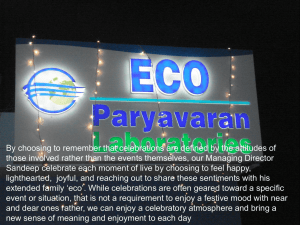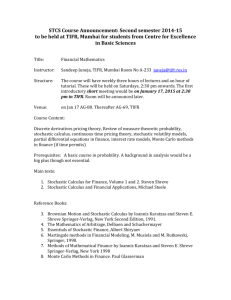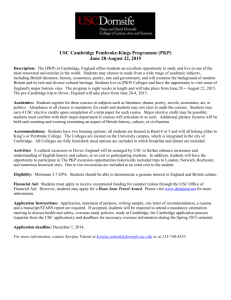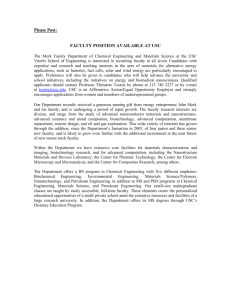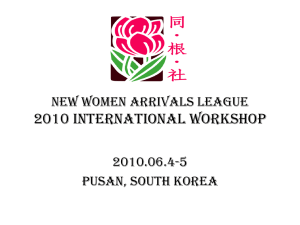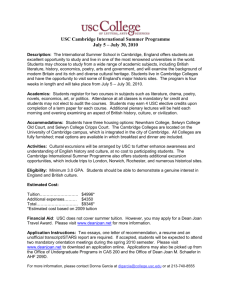The Concert/Cafeteria Queueing Problem A Game of Arrivals
advertisement
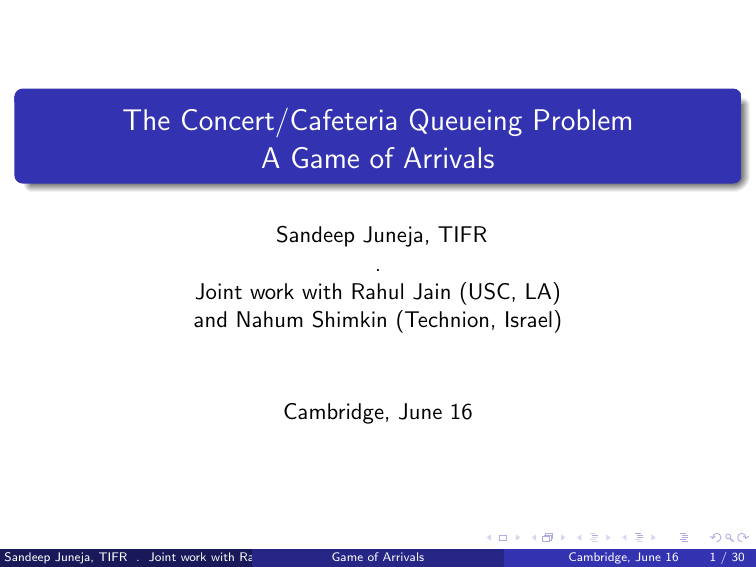
The Concert/Cafeteria Queueing Problem
A Game of Arrivals
Sandeep Juneja, TIFR
.
Joint work with Rahul Jain (USC, LA)
and Nahum Shimkin (Technion, Israel)
Cambridge, June 16
Sandeep Juneja, TIFR . Joint work with Rahul Jain (USC,Game
LA) of
and
Arrivals
Nahum Shimkin (Technion, Israel)
Cambridge,
()
June 16
1 / 30
Concert or Cafeteria Queueing Problem: Framework
Finite but large number of customers
Server becomes active at time zero
Customers can come and queue up before or after time zero
Customer cost is additive and linear in waiting time and service
completion time
Multi-class allowed in that the cost coefficients may differ.
Sandeep Juneja, TIFR . Joint work with Rahul Jain (USC,Game
LA) of
and
Arrivals
Nahum Shimkin (Technion, Israel)
Cambridge,
()
June 16
2 / 30
Concert or Cafeteria Queueing Problem: Framework
Finite but large number of customers
Server becomes active at time zero
Customers can come and queue up before or after time zero
Customer cost is additive and linear in waiting time and service
completion time
Multi-class allowed in that the cost coefficients may differ.
Sandeep Juneja, TIFR . Joint work with Rahul Jain (USC,Game
LA) of
and
Arrivals
Nahum Shimkin (Technion, Israel)
Cambridge,
()
June 16
2 / 30
Concert or Cafeteria Queueing Problem: Framework
Finite but large number of customers
Server becomes active at time zero
Customers can come and queue up before or after time zero
Customer cost is additive and linear in waiting time and service
completion time
Multi-class allowed in that the cost coefficients may differ.
Sandeep Juneja, TIFR . Joint work with Rahul Jain (USC,Game
LA) of
and
Arrivals
Nahum Shimkin (Technion, Israel)
Cambridge,
()
June 16
2 / 30
Concert or Cafeteria Queueing Problem: Framework
Finite but large number of customers
Server becomes active at time zero
Customers can come and queue up before or after time zero
Customer cost is additive and linear in waiting time and service
completion time
Multi-class allowed in that the cost coefficients may differ.
Sandeep Juneja, TIFR . Joint work with Rahul Jain (USC,Game
LA) of
and
Arrivals
Nahum Shimkin (Technion, Israel)
Cambridge,
()
June 16
2 / 30
Concert or Cafeteria Queueing Problem: Framework
Finite but large number of customers
Server becomes active at time zero
Customers can come and queue up before or after time zero
Customer cost is additive and linear in waiting time and service
completion time
Multi-class allowed in that the cost coefficients may differ.
Sandeep Juneja, TIFR . Joint work with Rahul Jain (USC,Game
LA) of
and
Arrivals
Nahum Shimkin (Technion, Israel)
Cambridge,
()
June 16
2 / 30
Concert or Cafeteria Queueing Problem: Contributions
We analyze the associated fluid model. Each customer is
infinitesimal, has negligible effect on others. This provides great
deal of analytical tractability
We show that the game has a unique Nash equilibrium point, and
explicitly identify this point.
We show that price of anarchy equals 2 in the single class
setting. We develop tight bounds on it in multi-class settings.
We study some methods to reduce anarchy: Service time
restrictions, assigning differing priorities, charging tariffs as a
function of time of service
Sandeep Juneja, TIFR . Joint work with Rahul Jain (USC,Game
LA) of
and
Arrivals
Nahum Shimkin (Technion, Israel)
Cambridge,
()
June 16
3 / 30
Concert or Cafeteria Queueing Problem: Contributions
We analyze the associated fluid model. Each customer is
infinitesimal, has negligible effect on others. This provides great
deal of analytical tractability
We show that the game has a unique Nash equilibrium point, and
explicitly identify this point.
We show that price of anarchy equals 2 in the single class
setting. We develop tight bounds on it in multi-class settings.
We study some methods to reduce anarchy: Service time
restrictions, assigning differing priorities, charging tariffs as a
function of time of service
Sandeep Juneja, TIFR . Joint work with Rahul Jain (USC,Game
LA) of
and
Arrivals
Nahum Shimkin (Technion, Israel)
Cambridge,
()
June 16
3 / 30
Concert or Cafeteria Queueing Problem: Contributions
We analyze the associated fluid model. Each customer is
infinitesimal, has negligible effect on others. This provides great
deal of analytical tractability
We show that the game has a unique Nash equilibrium point, and
explicitly identify this point.
We show that price of anarchy equals 2 in the single class
setting. We develop tight bounds on it in multi-class settings.
We study some methods to reduce anarchy: Service time
restrictions, assigning differing priorities, charging tariffs as a
function of time of service
Sandeep Juneja, TIFR . Joint work with Rahul Jain (USC,Game
LA) of
and
Arrivals
Nahum Shimkin (Technion, Israel)
Cambridge,
()
June 16
3 / 30
Concert or Cafeteria Queueing Problem: Contributions
We analyze the associated fluid model. Each customer is
infinitesimal, has negligible effect on others. This provides great
deal of analytical tractability
We show that the game has a unique Nash equilibrium point, and
explicitly identify this point.
We show that price of anarchy equals 2 in the single class
setting. We develop tight bounds on it in multi-class settings.
We study some methods to reduce anarchy: Service time
restrictions, assigning differing priorities, charging tariffs as a
function of time of service
Sandeep Juneja, TIFR . Joint work with Rahul Jain (USC,Game
LA) of
and
Arrivals
Nahum Shimkin (Technion, Israel)
Cambridge,
()
June 16
3 / 30
Some Motivations
The hard to beat long queue at TIFR canteen
Concert, movie theater, passport and DMV office queueing: Cost
to going late, going early may involve large wait in queues
We also study a modification: Cost may not be a function of
time, but of number of customers that have arrived earlier
Sandeep Juneja, TIFR . Joint work with Rahul Jain (USC,Game
LA) of
and
Arrivals
Nahum Shimkin (Technion, Israel)
Cambridge,
()
June 16
4 / 30
Some Motivations
The hard to beat long queue at TIFR canteen
Concert, movie theater, passport and DMV office queueing: Cost
to going late, going early may involve large wait in queues
We also study a modification: Cost may not be a function of
time, but of number of customers that have arrived earlier
Sandeep Juneja, TIFR . Joint work with Rahul Jain (USC,Game
LA) of
and
Arrivals
Nahum Shimkin (Technion, Israel)
Cambridge,
()
June 16
4 / 30
Some Motivations
The hard to beat long queue at TIFR canteen
Concert, movie theater, passport and DMV office queueing: Cost
to going late, going early may involve large wait in queues
We also study a modification: Cost may not be a function of
time, but of number of customers that have arrived earlier
Sandeep Juneja, TIFR . Joint work with Rahul Jain (USC,Game
LA) of
and
Arrivals
Nahum Shimkin (Technion, Israel)
Cambridge,
()
June 16
4 / 30
Long Queues
Sandeep Juneja, TIFR . Joint work with Rahul Jain (USC,Game
LA) of
and
Arrivals
Nahum Shimkin (Technion, Israel)
Cambridge,
()
June 16
5 / 30
Related Literature: Strategic Timing Decisions
Extensive literature studying admissions control, routing,
reneging, pricing etc. Summarized in monograph by Hassin and
Haviv (2003).
Equlibrium arrival patterns with finite service periods considered
by Glazer and Hassin 1983. Number of arrivals Poisson,
Exponential service times, only waiting costs
Transportation science literature: Substantial on equilibrium fluid
models for traffic including Lindsay (2004), Newell (1987), Smith
(1984), Hendrickson and Kocur (1981), Daganzo (1985, 98)
Sandeep Juneja, TIFR . Joint work with Rahul Jain (USC,Game
LA) of
and
Arrivals
Nahum Shimkin (Technion, Israel)
Cambridge,
()
June 16
6 / 30
Related Literature: Strategic Timing Decisions
Extensive literature studying admissions control, routing,
reneging, pricing etc. Summarized in monograph by Hassin and
Haviv (2003).
Equlibrium arrival patterns with finite service periods considered
by Glazer and Hassin 1983. Number of arrivals Poisson,
Exponential service times, only waiting costs
Transportation science literature: Substantial on equilibrium fluid
models for traffic including Lindsay (2004), Newell (1987), Smith
(1984), Hendrickson and Kocur (1981), Daganzo (1985, 98)
Sandeep Juneja, TIFR . Joint work with Rahul Jain (USC,Game
LA) of
and
Arrivals
Nahum Shimkin (Technion, Israel)
Cambridge,
()
June 16
6 / 30
Mathematical Framework: Asymptotic Analysis
Series of queueing systems indexed by n
For system n, there are n customers. Customer i picks arrival time
from Fi (·).
There exists an arrival profile F (t) such that
n
1X
Fi (nt) → F (t)
n
i=1
so fraction of arrivals by time nt are stabilizing to F(t).
Sandeep Juneja, TIFR . Joint work with Rahul Jain (USC,Game
LA) of
and
Arrivals
Nahum Shimkin (Technion, Israel)
Cambridge,
()
June 16
7 / 30
Mathematical Framework: Asymptotic Analysis
Series of queueing systems indexed by n
For system n, there are n customers. Customer i picks arrival time
from Fi (·).
There exists an arrival profile F (t) such that
n
1X
Fi (nt) → F (t)
n
i=1
so fraction of arrivals by time nt are stabilizing to F(t).
Sandeep Juneja, TIFR . Joint work with Rahul Jain (USC,Game
LA) of
and
Arrivals
Nahum Shimkin (Technion, Israel)
Cambridge,
()
June 16
7 / 30
Mathematical Framework: Asymptotic Analysis
Series of queueing systems indexed by n
For system n, there are n customers. Customer i picks arrival time
from Fi (·).
There exists an arrival profile F (t) such that
n
1X
Fi (nt) → F (t)
n
i=1
so fraction of arrivals by time nt are stabilizing to F(t).
Sandeep Juneja, TIFR . Joint work with Rahul Jain (USC,Game
LA) of
and
Arrivals
Nahum Shimkin (Technion, Israel)
Cambridge,
()
June 16
7 / 30
Service Process Fluid Limit
The service time of each customer is are independent identically
distributed.
We have
Sn (nt)
→ µt
n
where Sn (nt) denotes the number of potential services completed in
time nt, t > 0, and µ denotes the service rate.
Sandeep Juneja, TIFR . Joint work with Rahul Jain (USC,Game
LA) of
and
Arrivals
Nahum Shimkin (Technion, Israel)
Cambridge,
()
June 16
8 / 30
Service Process Fluid Limit
The service time of each customer is are independent identically
distributed.
We have
Sn (nt)
→ µt
n
where Sn (nt) denotes the number of potential services completed in
time nt, t > 0, and µ denotes the service rate.
Sandeep Juneja, TIFR . Joint work with Rahul Jain (USC,Game
LA) of
and
Arrivals
Nahum Shimkin (Technion, Israel)
Cambridge,
()
June 16
8 / 30
Fluid Limit of Net Input
The limiting net input process: Arrivals - potential service completions
X (t) = F (t),
for t < 0.
For t > 0,
X (t) = F (t) − µt.
Sandeep Juneja, TIFR . Joint work with Rahul Jain (USC,Game
LA) of
and
Arrivals
Nahum Shimkin (Technion, Israel)
Cambridge,
()
June 16
9 / 30
Fluid Limit of Net Input
The limiting net input process: Arrivals - potential service completions
X (t) = F (t),
for t < 0.
For t > 0,
X (t) = F (t) − µt.
Sandeep Juneja, TIFR . Joint work with Rahul Jain (USC,Game
LA) of
and
Arrivals
Nahum Shimkin (Technion, Israel)
Cambridge,
()
June 16
9 / 30
Queue Length Fluid Limit
The limiting queue length process
Q(t) = X (t) = F (t)
for t < 0.
For t > 0,
Q(t) = X (t) − inf [X (s) ∧ 0]
0≤s≤t
where − inf 0≤s≤t [X (s) ∧ 0] denotes the unused capacity by time t
If the queue has not emptied till time t > 0, then
Q̄(t) = F (t) − µt.
Sandeep Juneja, TIFR . Joint work with Rahul Jain (USC,Game
LA) of
and
Arrivals
Nahum Shimkin (Technion, Israel)
Cambridge,
()
June 16
10 / 30
Queue Length Fluid Limit
The limiting queue length process
Q(t) = X (t) = F (t)
for t < 0.
For t > 0,
Q(t) = X (t) − inf [X (s) ∧ 0]
0≤s≤t
where − inf 0≤s≤t [X (s) ∧ 0] denotes the unused capacity by time t
If the queue has not emptied till time t > 0, then
Q̄(t) = F (t) − µt.
Sandeep Juneja, TIFR . Joint work with Rahul Jain (USC,Game
LA) of
and
Arrivals
Nahum Shimkin (Technion, Israel)
Cambridge,
()
June 16
10 / 30
Queue Length Fluid Limit
The limiting queue length process
Q(t) = X (t) = F (t)
for t < 0.
For t > 0,
Q(t) = X (t) − inf [X (s) ∧ 0]
0≤s≤t
where − inf 0≤s≤t [X (s) ∧ 0] denotes the unused capacity by time t
If the queue has not emptied till time t > 0, then
Q̄(t) = F (t) − µt.
Sandeep Juneja, TIFR . Joint work with Rahul Jain (USC,Game
LA) of
and
Arrivals
Nahum Shimkin (Technion, Israel)
Cambridge,
()
June 16
10 / 30
Queue Length Process
Sandeep Juneja, TIFR . Joint work with Rahul Jain (USC,Game
LA) of
and
Arrivals
Nahum Shimkin (Technion, Israel)
Cambridge,
()
June 16
11 / 30
Queue Length Process: Server Fully Loaded
Sandeep Juneja, TIFR . Joint work with Rahul Jain (USC,Game
LA) of
and
Arrivals
Nahum Shimkin (Technion, Israel)
Cambridge,
()
June 16
12 / 30
When to ‘Arrive’
Let WF (t) denote waiting time for arrival at time t when all
other customers have an arrival profile F .
Arrival at time t incurs cost
CF (t) = αWF (t) + β(t + WF (t))
More generally, the expected cost incurred by a customer who
selects her arrival by sampling from probability distribution G is
Z ∞
CF (G ) =
(αWF (t) + β(t + WF (t))) dG (t) .
−∞
Sandeep Juneja, TIFR . Joint work with Rahul Jain (USC,Game
LA) of
and
Arrivals
Nahum Shimkin (Technion, Israel)
Cambridge,
()
June 16
13 / 30
Nash Equilibrium
A multi-strategy {Gs (·), s ∈ [0, 1]} is a Nash equilibrium point if
R1
(i) F (t) = 0 Gs (t)ds is well defined for each t, and
(ii) For any customer s ∈ [0, 1],
CF (Gs ) ≤ CF (G̃ ),
for every CDF G̃ .
That is, no customer s can improve his cost by modifying his
own arrival time distribution.
This corresponds to finding an arrival profile F such that CF (t) is
constant on its support and higher elsewhere.
Sandeep Juneja, TIFR . Joint work with Rahul Jain (USC,Game
LA) of
and
Arrivals
Nahum Shimkin (Technion, Israel)
Cambridge,
()
June 16
14 / 30
Useful Insights
Let t ∗ = inf{t ≥ 0 : F (t) < µt}.
In Nash Equilibrium, first time the server has spare capacity is
when all customers are served. That is t ∗ = 1/µ.
Similarly, in Nash equilibrium there can be no point masses in F .
Sandeep Juneja, TIFR . Joint work with Rahul Jain (USC,Game
LA) of
and
Arrivals
Nahum Shimkin (Technion, Israel)
Cambridge,
()
June 16
15 / 30
Useful Insights
Let t ∗ = inf{t ≥ 0 : F (t) < µt}.
In Nash Equilibrium, first time the server has spare capacity is
when all customers are served. That is t ∗ = 1/µ.
Similarly, in Nash equilibrium there can be no point masses in F .
Sandeep Juneja, TIFR . Joint work with Rahul Jain (USC,Game
LA) of
and
Arrivals
Nahum Shimkin (Technion, Israel)
Cambridge,
()
June 16
15 / 30
Cost Function under Equilibrium
If F (·) denotes an equilibrium profile Then, W (t) equals
F (t)/µ − t.
The cost function CF (t) equals
β(t + W (t)) + αW (t) = (α + β)F (t)/µ − αt
For this to be independent of time F should be uniformly
distributed
Sandeep Juneja, TIFR . Joint work with Rahul Jain (USC,Game
LA) of
and
Arrivals
Nahum Shimkin (Technion, Israel)
Cambridge,
()
June 16
16 / 30
Cost Function under Equilibrium
If F (·) denotes an equilibrium profile Then, W (t) equals
F (t)/µ − t.
The cost function CF (t) equals
β(t + W (t)) + αW (t) = (α + β)F (t)/µ − αt
For this to be independent of time F should be uniformly
distributed
Sandeep Juneja, TIFR . Joint work with Rahul Jain (USC,Game
LA) of
and
Arrivals
Nahum Shimkin (Technion, Israel)
Cambridge,
()
June 16
16 / 30
Cost Function under Equilibrium
If F (·) denotes an equilibrium profile Then, W (t) equals
F (t)/µ − t.
The cost function CF (t) equals
β(t + W (t)) + αW (t) = (α + β)F (t)/µ − αt
For this to be independent of time F should be uniformly
distributed
Sandeep Juneja, TIFR . Joint work with Rahul Jain (USC,Game
LA) of
and
Arrivals
Nahum Shimkin (Technion, Israel)
Cambridge,
()
June 16
16 / 30
Queue Length Process
Higher the β (time to service cost), higher the queue.
Sandeep Juneja, TIFR . Joint work with Rahul Jain (USC,Game
LA) of
and
Arrivals
Nahum Shimkin (Technion, Israel)
Cambridge,
()
June 16
17 / 30
Socially Optimal Solution
The smallest value of waiting time is zero.
Total time to service is minimized if the server serves at the
fastest possible rate. So the lower bound on average service time
is 1/(2µ) and on the overall cost is β/(2µ)
Easy to achieve. Price of anarchy equals two
Sandeep Juneja, TIFR . Joint work with Rahul Jain (USC,Game
LA) of
and
Arrivals
Nahum Shimkin (Technion, Israel)
Cambridge,
()
June 16
18 / 30
Socially Optimal Solution
The smallest value of waiting time is zero.
Total time to service is minimized if the server serves at the
fastest possible rate. So the lower bound on average service time
is 1/(2µ) and on the overall cost is β/(2µ)
Easy to achieve. Price of anarchy equals two
Sandeep Juneja, TIFR . Joint work with Rahul Jain (USC,Game
LA) of
and
Arrivals
Nahum Shimkin (Technion, Israel)
Cambridge,
()
June 16
18 / 30
Socially Optimal Solution
The smallest value of waiting time is zero.
Total time to service is minimized if the server serves at the
fastest possible rate. So the lower bound on average service time
is 1/(2µ) and on the overall cost is β/(2µ)
Easy to achieve. Price of anarchy equals two
Sandeep Juneja, TIFR . Joint work with Rahul Jain (USC,Game
LA) of
and
Arrivals
Nahum Shimkin (Technion, Israel)
Cambridge,
()
June 16
18 / 30
Multi-Class Customers with Linear Costs
In equilibrium the different classes separate into disjoint intervals
and arrive in descending order of βi /αi .
Sandeep Juneja, TIFR . Joint work with Rahul Jain (USC,Game
LA) of
and
Arrivals
Nahum Shimkin (Technion, Israel)
Cambridge,
()
June 16
19 / 30
Multi-Class Customers, Social optimal, POA
Class with higher β comes earlier. No queueing.
When all αi are equal, the POA equals 2
Let Gmax = maxi,j G (i, j) and Gmin = mini,j G (i, j), where
β
G (i, j) =
(αi + αj ) min{ αβii , αjj }
2 min{βi , βj }
.
Then
2Gmin ≤ PoA ≤ 2Gmax .
Sandeep Juneja, TIFR . Joint work with Rahul Jain (USC,Game
LA) of
and
Arrivals
Nahum Shimkin (Technion, Israel)
Cambridge,
()
June 16
20 / 30
Multi-Class Customers, Social optimal, POA
Class with higher β comes earlier. No queueing.
When all αi are equal, the POA equals 2
Let Gmax = maxi,j G (i, j) and Gmin = mini,j G (i, j), where
β
G (i, j) =
(αi + αj ) min{ αβii , αjj }
2 min{βi , βj }
.
Then
2Gmin ≤ PoA ≤ 2Gmax .
Sandeep Juneja, TIFR . Joint work with Rahul Jain (USC,Game
LA) of
and
Arrivals
Nahum Shimkin (Technion, Israel)
Cambridge,
()
June 16
20 / 30
Multi-Class Customers, Social optimal, POA
Class with higher β comes earlier. No queueing.
When all αi are equal, the POA equals 2
Let Gmax = maxi,j G (i, j) and Gmin = mini,j G (i, j), where
β
G (i, j) =
(αi + αj ) min{ αβii , αjj }
2 min{βi , βj }
.
Then
2Gmin ≤ PoA ≤ 2Gmax .
Sandeep Juneja, TIFR . Joint work with Rahul Jain (USC,Game
LA) of
and
Arrivals
Nahum Shimkin (Technion, Israel)
Cambridge,
()
June 16
20 / 30
Reducing Anarchy: Service Time Restrictions
Here (1 − a) proportion is allowed to be served after time a/µ.
PoA equals 2(a2 + (1 − a)).
Minimised to 3/2 at a=1/2.
Sandeep Juneja, TIFR . Joint work with Rahul Jain (USC,Game
LA) of
and
Arrivals
Nahum Shimkin (Technion, Israel)
Cambridge,
()
June 16
21 / 30
Reducing Price of Anarchy
One generalization: m/n proportion of people come after time
(n − m)/nµ, for m = 1, 2, 3, . . . , n − 1.
Easy to see that POLA now equals (n + 1)/n and converges to 1
as n → ∞.
Sandeep Juneja, TIFR . Joint work with Rahul Jain (USC,Game
LA) of
and
Arrivals
Nahum Shimkin (Technion, Israel)
Cambridge,
()
June 16
22 / 30
Reducing PoA: Differential Pricing
Charge the customers that come in the first half p =
β
The queue reduces by half. Cafeteria gain equals 4µ
.
β
2µ
Sandeep Juneja, TIFR . Joint work with Rahul Jain (USC,Game
LA) of
and
Arrivals
Nahum Shimkin (Technion, Israel)
Cambridge,
()
June 16
23 / 30
If the amount charged is higher
Charge the customers that come in the first half p >
Cafeteria gains more.
9 β
Its optimal p = 34 βµ and revenue 32
.
µ
β
2µ
Sandeep Juneja, TIFR . Joint work with Rahul Jain (USC,Game
LA) of
and
Arrivals
Nahum Shimkin (Technion, Israel)
Cambridge,
()
June 16
24 / 30
If amount charged is lower
Better to err with lower prices than higher prices
Sandeep Juneja, TIFR . Joint work with Rahul Jain (USC,Game
LA) of
and
Arrivals
Nahum Shimkin (Technion, Israel)
Cambridge,
()
June 16
25 / 30
Modified Cost Structure
Replace the cost
β(t + W (t)) + αW (t)
with
βF (t) + αW (t).
The overall cost now equals
F (t)
(α + β̂) − αt,
µ
where β̂ = βµ.
This differs from the previously analyzed cost function in that β̂
replaces β. Price of Anarchy Remains 2
Sandeep Juneja, TIFR . Joint work with Rahul Jain (USC,Game
LA) of
and
Arrivals
Nahum Shimkin (Technion, Israel)
Cambridge,
()
June 16
26 / 30
Modified Cost Structure
Replace the cost
β(t + W (t)) + αW (t)
with
βF (t) + αW (t).
The overall cost now equals
F (t)
(α + β̂) − αt,
µ
where β̂ = βµ.
This differs from the previously analyzed cost function in that β̂
replaces β. Price of Anarchy Remains 2
Sandeep Juneja, TIFR . Joint work with Rahul Jain (USC,Game
LA) of
and
Arrivals
Nahum Shimkin (Technion, Israel)
Cambridge,
()
June 16
26 / 30
Modified Cost Structure
Replace the cost
β(t + W (t)) + αW (t)
with
βF (t) + αW (t).
The overall cost now equals
F (t)
(α + β̂) − αt,
µ
where β̂ = βµ.
This differs from the previously analyzed cost function in that β̂
replaces β. Price of Anarchy Remains 2
Sandeep Juneja, TIFR . Joint work with Rahul Jain (USC,Game
LA) of
and
Arrivals
Nahum Shimkin (Technion, Israel)
Cambridge,
()
June 16
26 / 30
Numerical Results
Uniform arrivals, exponential service times
1.8
N=10,000
N=1,000
N=500
N=100
N=50
N=10
1.6
1.4
1.2
1
0.8
0.6
0.4
0.2
0
-0.6
-0.4
-0.2
0
0.2
0.4
0.6
0.8
1
Normalized arrival time
Sandeep Juneja, TIFR . Joint work with Rahul Jain (USC,Game
LA) of
and
Arrivals
Nahum Shimkin (Technion, Israel)
Cambridge,
()
June 16
27 / 30
Numerical Results
Deterministic arrivals, uniform (less variable) service times
1.8
N=10,000
N=1,000
N=500
N=100
N=50
N=10
1.6
1.4
1.2
1
0.8
0.6
0.4
0.2
0
-0.6
-0.4
-0.2
0
0.2
0.4
0.6
0.8
1
Normalized arrival time
Sandeep Juneja, TIFR . Joint work with Rahul Jain (USC,Game
LA) of
and
Arrivals
Nahum Shimkin (Technion, Israel)
Cambridge,
()
June 16
28 / 30
Non-linear Costs, Multi-class Customers
Adapted from Lindsay (2004). Waiting times for iso-cost curves.
Upper envelope gives equilibrium schedule for the achieved
capacities
Computational algorithm to solve for given capacities. Simple
uniqueness proof
Sandeep Juneja, TIFR . Joint work with Rahul Jain (USC,Game
LA) of
and
Arrivals
Nahum Shimkin (Technion, Israel)
Cambridge,
()
June 16
29 / 30
Non-linear Costs, Multi-class Customers
Adapted from Lindsay (2004). Waiting times for iso-cost curves.
Upper envelope gives equilibrium schedule for the achieved
capacities
Computational algorithm to solve for given capacities. Simple
uniqueness proof
Sandeep Juneja, TIFR . Joint work with Rahul Jain (USC,Game
LA) of
and
Arrivals
Nahum Shimkin (Technion, Israel)
Cambridge,
()
June 16
29 / 30
Non-linear Costs, Multi-class Customers
Adapted from Lindsay (2004). Waiting times for iso-cost curves.
Upper envelope gives equilibrium schedule for the achieved
capacities
Computational algorithm to solve for given capacities. Simple
uniqueness proof
Sandeep Juneja, TIFR . Joint work with Rahul Jain (USC,Game
LA) of
and
Arrivals
Nahum Shimkin (Technion, Israel)
Cambridge,
()
June 16
29 / 30
Conclusions
We considered the queueing problem that may arise in settings
such as concert halls, movie theaters, cafeterias etc.
The customers strategically selected their arrival time
distributions.
We developed a queueing framework and identified the fluid
limit. Fluid limits allow a great deal of tractability in analyzing
the strategic arrival problem faced by each customer.
We identified a Nash equilibrium strategy in multi-class setting
with linear costs and showed bounds on price of anarchy.
We discussed some ways to control price of anarchy
We discussed equilibrium strategies under non-linear costs and
algorithms to identify these.
Sandeep Juneja, TIFR . Joint work with Rahul Jain (USC,Game
LA) of
and
Arrivals
Nahum Shimkin (Technion, Israel)
Cambridge,
()
June 16
30 / 30
Conclusions
We considered the queueing problem that may arise in settings
such as concert halls, movie theaters, cafeterias etc.
The customers strategically selected their arrival time
distributions.
We developed a queueing framework and identified the fluid
limit. Fluid limits allow a great deal of tractability in analyzing
the strategic arrival problem faced by each customer.
We identified a Nash equilibrium strategy in multi-class setting
with linear costs and showed bounds on price of anarchy.
We discussed some ways to control price of anarchy
We discussed equilibrium strategies under non-linear costs and
algorithms to identify these.
Sandeep Juneja, TIFR . Joint work with Rahul Jain (USC,Game
LA) of
and
Arrivals
Nahum Shimkin (Technion, Israel)
Cambridge,
()
June 16
30 / 30
Conclusions
We considered the queueing problem that may arise in settings
such as concert halls, movie theaters, cafeterias etc.
The customers strategically selected their arrival time
distributions.
We developed a queueing framework and identified the fluid
limit. Fluid limits allow a great deal of tractability in analyzing
the strategic arrival problem faced by each customer.
We identified a Nash equilibrium strategy in multi-class setting
with linear costs and showed bounds on price of anarchy.
We discussed some ways to control price of anarchy
We discussed equilibrium strategies under non-linear costs and
algorithms to identify these.
Sandeep Juneja, TIFR . Joint work with Rahul Jain (USC,Game
LA) of
and
Arrivals
Nahum Shimkin (Technion, Israel)
Cambridge,
()
June 16
30 / 30
Conclusions
We considered the queueing problem that may arise in settings
such as concert halls, movie theaters, cafeterias etc.
The customers strategically selected their arrival time
distributions.
We developed a queueing framework and identified the fluid
limit. Fluid limits allow a great deal of tractability in analyzing
the strategic arrival problem faced by each customer.
We identified a Nash equilibrium strategy in multi-class setting
with linear costs and showed bounds on price of anarchy.
We discussed some ways to control price of anarchy
We discussed equilibrium strategies under non-linear costs and
algorithms to identify these.
Sandeep Juneja, TIFR . Joint work with Rahul Jain (USC,Game
LA) of
and
Arrivals
Nahum Shimkin (Technion, Israel)
Cambridge,
()
June 16
30 / 30
Conclusions
We considered the queueing problem that may arise in settings
such as concert halls, movie theaters, cafeterias etc.
The customers strategically selected their arrival time
distributions.
We developed a queueing framework and identified the fluid
limit. Fluid limits allow a great deal of tractability in analyzing
the strategic arrival problem faced by each customer.
We identified a Nash equilibrium strategy in multi-class setting
with linear costs and showed bounds on price of anarchy.
We discussed some ways to control price of anarchy
We discussed equilibrium strategies under non-linear costs and
algorithms to identify these.
Sandeep Juneja, TIFR . Joint work with Rahul Jain (USC,Game
LA) of
and
Arrivals
Nahum Shimkin (Technion, Israel)
Cambridge,
()
June 16
30 / 30
Conclusions
We considered the queueing problem that may arise in settings
such as concert halls, movie theaters, cafeterias etc.
The customers strategically selected their arrival time
distributions.
We developed a queueing framework and identified the fluid
limit. Fluid limits allow a great deal of tractability in analyzing
the strategic arrival problem faced by each customer.
We identified a Nash equilibrium strategy in multi-class setting
with linear costs and showed bounds on price of anarchy.
We discussed some ways to control price of anarchy
We discussed equilibrium strategies under non-linear costs and
algorithms to identify these.
Sandeep Juneja, TIFR . Joint work with Rahul Jain (USC,Game
LA) of
and
Arrivals
Nahum Shimkin (Technion, Israel)
Cambridge,
()
June 16
30 / 30
